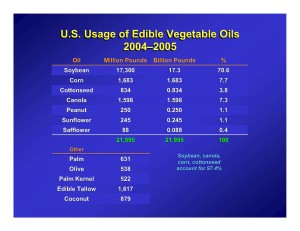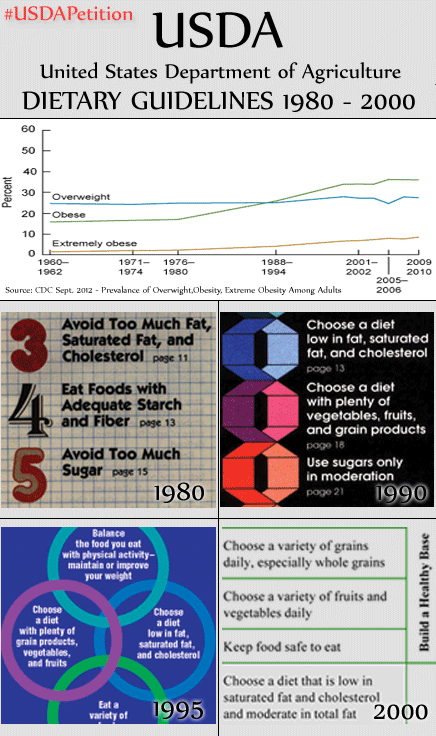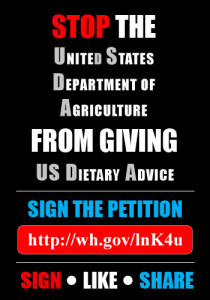I recently found myself reading the article “If the Low-Fat Diet Is a Lie, What the Hell Should We Eat?” located on Elle’s website. I thought the author Jane Black did a terrific job illustrating the frustration the average consumer has on this conflicting information. I enjoyed the background information on where we were and where we are today. It was a very informational and well balanced article.
I placed a comment on Elle’s site to share my thoughts regarding fat and the part of the article about how we knew “low-fat” meant more vegetables and not snack-wells. My comment is at the bottom of this post.
Firstly, the USDA has dropped Total Fat (TF) recommendations in the general verbiage (That lame chart in Appendix E-37 Table 4 leaves much more to be desired though) of the latest Dietary Guideline Advisory Committee (DGAC) report located here. I welcome this because it was ridiculous to limit fat in the first place as fat was not the problem as some have been arguing this for decades. Dr. Katz recommends we focus on “themes of healthy eating: diets that center on minimally processed foods and lots of fruit and vegetables. ‘We need to focus on foods and forget about the nutrients,'”.
I completely agree with him on this. I will take that one step further and say that Natural Fats (NFs), which include Saturated Fatty Acids (SFAs) that are also minimally processed, belong in this healthy eating theme. Let all minimally processed foods be fair game and the let the individual’s situation dictate what they need to do. I’m not the “no-carbs” guy, the “all-carbs”, “no-meat” or “all-meat” guy. We all have different dietary requirements and it is wise to not try and replace one dogma with another. The universal theme across all popular heritage, traditional and modern diets that revolve around real food: more real food (to include minimally processed food) and less (to no) processed refined garbage with added sugars, oils, fats, chemicals, etc. The individual variance in the diet is related to heritage, genes and personal preference; nearly all limit what you’d find beyond the perimeter of the grocery store.
Let the macronutrient ratio of the diet become unimportant so long as it provides the necessary nutriment to the person ingesting the diet. The American Nutritional Forefather W.O. Atwater (Also worked at the USDA) stated “the most healthful food is that which is best fitted to the needs of the user”. Let those who wish to restrict fat, meat, carbs, dairy, wheat, etc. do so as long as they acquire the nutriment they need.
Here is the comment I posted on the Elle website:
A lot of the promotion of foods containing saturated fat is completely aligned with what Katz stated. We are promoting real food. Natural saturated fats (Note that there are many types of Saturated Fat) are real food and fit into a healthy dietary pattern. We are being told, “No, you can’t say that SFA is OK. You need to focus on foods and forget about the nutrients. No, not that real food, that has Saturated Fat, are you insane!”. WTF??? According to the USDA’s Dietary Guideline Advisory Committee (DGAC) report “In the United States, the top sources of foods contributing to saturated fat intake are mixed dishes, particularly burgers and sandwiches, and snacks and sweets”. You can’t blame the impact of the highly refined mixed food on ones health on the Saturated Fat that was present in the product. To me, that is not different …than saying vegetables are unhealthy because they are in supreme pizza.
I disagree very strongly that everyone knew that “low-fat” meant less fat and more vegetables. That is BS in my opinion. Look at the bottom of the food pyramid and tell me they (The government) really meant more vegetables. Detach your profession from this and imagine you are the consumer. Luise Light’s recommendations to the USDA meant more vegetables (5-9srv) and less grain (2-3srv), her bosses decided that more grains were needed for all instead (6-11srv). Tell me where the healthy vegetables are in the 6-11 servings of grains we were told to eat per day. Be mindful that we were not told to eat whole grain, we were told to eat grain. Even in the earlier guidelines it was clear that grain should be consumed. The grain recommended was not whole grain. Sure, the professionals that do this for a living might have knew whole grain and more vegetables, but the whole system did a shitty job of communicating that to the consumer. Then again, Cocoa Puffs had the heart check logo and I can’t find that shit on a bag of carrots. The AHA must want us to eat more vegetables too.
Look at this post which outlines the various dietary guideline releases: http://www.dietarydogma.com/historical-view-obesity-dietary-guidelines/
Thanks for your time and have a nice day.
So, what are your thoughts?



